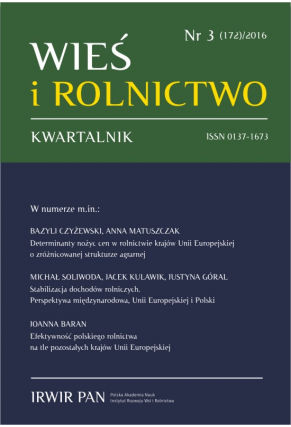Zasoby pracy w polskich gospodarstwach z perspektywy pracowniczych spółdzielni rolniczych
DOI:
https://doi.org/10.53098/wir032017/04Słowa kluczowe:
rolnicze spółdzielnie produkcyjne, podmioty rolne, zatrudnienie, rentownośćAbstrakt
W artykule skupiono się na porównaniu wielkości zasobów pracy pomiędzy spółdzielniami i innymi typami przedsiębiorstw w polskim rolnictwie. W szczególności celem artykułu było przeanalizowanie wynikających z tego różnic w kontekście zatrudnienia. Analiza empiryczna została wykonana na przykładzie polskich rolniczych spółdzielni produkcyjnych oraz innych podmiotów rolnych. Artykuł przynosi odpowiedzi na następujące pytania badawcze: czy rolnicze spółdzielnie produkcyjne zapewniają większe zatrudnienie niż pozostałe podmioty rolne? Jaki był i jaki będzie poziom zatrudnienia w rolniczych spółdzielniach produkcyjnych i innych podmiotach rolnych? Jak poziom zatrudnienia wpływa na rentowność rolniczych spółdzielni produkcyjnych i innych podmiotów rolnych? Wnioski zostały opracowane na podstawie analizy „Lista 300 najlepszych przedsiębiorstw rolnych” przygotowanej przez Instytut Ekonomiki Rolnictwa i Gospodarki Żywnościowej – Państwowy Instytut Badawczy. Podmiotami analizy były następujące przedsiębiorstwa rolne: rolnicze spółdzielnie produkcyjne, spółki skarbu państwa, indywidualne gospodarstwa rolne, spółki prywatne i inne podmioty rolne. Zakres czasowy badań obejmował lata 2009–2015. W porównaniach wykorzystano analizę wariancji, metodę ekstrapolacji oraz analizę korelacji.Najważniejszy wniosek jest taki, że nie występują jasne, istotne różnice pomiędzy rolniczymi spółdzielniami produkcyjnymi i innymi podmiotami rolnymi w kontekście poziomu zatrudnienia, jego wpływu na rentowność oraz częściowo jego wzrostu. Jednak niektóre ze spółdzielni są zdolne do kreowania nowych miejsc pracy. Ponadto potrafią zwiększać rentowność sprzedaży wraz ze wzrostem zatrudnienia i utrzymywać dotychczasowe miejsca pracy nawet w czasach globalnego kryzysu.
Bibliografia
Alves G., Burdin G., Dean A. (2016). Workplace democracy and job flows. Journal of Comparative Economics, 44, 258–268. DOI: https://doi.org/10.1016/j.jce.2015.09.001
Babalola Y.A., Tiamiyu R., (2013). Cooperatives Enterprises: A panacea to job creation and economic empowerment. Information and Knowledge Management, 3 (5), 61.
Belloc F. (2017). What deters labour-owned firm creation? Evidence from Italian manufacturing sectors. Journal of Comparative Economics, 45, 139–153. DOI: https://doi.org/10.1016/j.jce.2016.12.001
Ben-Ner A. (1984). On the stability of the cooperative form of organization. Journal of Comparative Economics, 8, 247–260. DOI: https://doi.org/10.1016/0147-5967(84)90055-6
Ben-Ner A., Montias J.M., Neuberger E. (1993). Basic issues in organizations: A comparative perspective. Journal of Comparative Economics, 17 (2), 207–242. DOI: https://doi.org/10.1006/jcec.1993.1024
Ben-Ner A., Ren T., Flint D. (2011). A sectoral comparison of wage levels and wage inequality in human services industries. Nonprofit and Voluntary Sector Quarterly, 40, 608–633. DOI: https://doi.org/10.1177/0899764010365012
Berman K., Berman M. (1989). An empirical test of the theory of the labour-managed firm. Journal of Comparative Economics, 13, 281–300. DOI: https://doi.org/10.1016/0147-5967(89)90005-X
Bijman J., Cechin A., Omta O., Pascucci S. (2013). Decomposing the member relationship in agricultural cooperatives: Implications for commitment. Agribusiness, 29 (1), 39-61. DOI: https://doi.org/10.1002/agr.21321
Bonin J. (1981). The theory of the labour-managed firm from the membership’s perspective with implications for marshallian industry supply. Journal of Comparative Economics, 5, 337–351. DOI: https://doi.org/10.1016/0147-5967(81)90054-8
Bowles S., Gintis H. (1996). The distribution of wealth and the viability of the democratic firm. In: P. Ugo, R. Robert (eds). Democracy and Efficiency in the Economic Enterprise (pp. 64–81). New York: Routledge. DOI: https://doi.org/10.4324/9780203011416.ch5
Bretos I., Marcuello C. (2017). Revisiting globalization challenges and opportunities in the development of cooperatives. Annals of Public and Cooperative Economics, 88 (1), 47–73. DOI: https://doi.org/10.1111/apce.12145
Brewer A., Browning M. (1982). On the employment decision of a labour managed firm. Economica, 49, 141–146. DOI: https://doi.org/10.2307/2553303
Brodziński M. (2014). Oblicza polskiej spółdzielczości wiejskiej. Geneza – rozwój – przyszłość. Warszawa: FREL.
Bumbescu S.S. (2015). Performance analysis in agriculture using Du Pont model. Sibiu Alma Mater University Journals, Series A. Economic Sciences, 8 (2), 41–47.
Burdin G. (2014). Are worker-managed firms more likely to fail than conventional enterprises? Evidence from Uruguay. ILR Review, 67 (1), 202–238. DOI: https://doi.org/10.1177/001979391406700108
Burdin G., Dean A. (2009). New evidence on wages and employment in worker cooperatives compared with capitalist firms. Journal of Comparative Economics, 37, 517–533. DOI: https://doi.org/10.1016/j.jce.2009.08.001
Burdin G., Dean A. (2012). Revisiting the objectives of worker-managed firms: An empirical assessment. Economic Systems, 36, 160–167. DOI: https://doi.org/10.1016/j.ecosys.2011.06.003
Chloupková J. (2002). European Cooperative Movement – Background and common denominators. Unit of Economic Working Papers, Copenhagen, Denmark: The Royal Veterinary and Agricultural University, 11.
Conover N., Molina F., Morris K. (1993). Creating Jobs Through Cooperative Development. Davis, California: National Economic Development & Law Center.
Craig B., Pencavel J. (1992). The behavior of workers cooperatives: The plywood companies of the Pacific Northwest. American Economic Review, 82 (5), 1083–1105.
Domar E.D. (1966). The Soviet collective farm as a producer co-operative. American Economic Review, 56, 734–757.
Dow G.K. (1986). Control rights, competitive markets, and the labour management debate. Journal of Comparative Economics, 10, 48–61. DOI: https://doi.org/10.1016/0147-5967(86)90118-6
Dow G.K. (1996). Replicating Walrasian equilibria using markets for membership in labour-managed firms. Economic Design, 2, 147–162. DOI: https://doi.org/10.1007/BF02499131
Dow G.K. (2003). Governing the Firm: Workers’ Control in Theory and Practice. Cambridge: Cambridge University Press. DOI: https://doi.org/10.1017/CBO9780511615849
Dzun W. (2009). Spółdzielnie produkcji rolnej w procesie przemian systemowych. Zagadnienia Ekonomiki Rolnej, 4, 74–87.
Estrin S. (1982). Long-run responses under self-management. Journal of Comparative Economics, 6, 363–378. DOI: https://doi.org/10.1016/0147-5967(82)90046-4
Feng L., Hendrikse G. (2011). Chain interdependencies, measurement problems and efficient governance structure: Cooperatives versus publicly listed firms. European Review of Agricultural Economics, 39 (2), 241–255. DOI: https://doi.org/10.1093/erae/jbr007
Fisher M.L., Krishnan J., Netessine S. (2006). Retail Store Execution: An Empirical Study. Working papers. https://pdfs.semanticscholar.org/0bb1/b85a38d93f69a9d9ccbd2df1e-6ab42bbc979.pdf [accessed: 11.12.2017].
Hendrikse G., Liang Q. (2013). Cooperative CEO identity and efficient governance: Member or outside CEO? Agribusiness, 29 (1), 23–38. DOI: https://doi.org/10.1002/agr.21326
Holtmann A., Idson T. (1993). Wage determination of registered nurses in proprietary and nonprofit nursing homes. Journal of Human Resources, 28, 55–79. DOI: https://doi.org/10.2307/146088
IAFE (2009–2015). List of the 300 best agricultural enterprises. http://www.ierigz.waw.pl/prace-badawcze/ranking-300 [accessed: 11.12.2017].
ILO (2013). Global Employment Trends for Youth 2013 – A generation at risk. Geneva: ILO.
ILO (2014a). Global Employment Trends 2014. Geneva: ILO.
ILO (2014b). World of Work: Migrant Workers Are Not a Commodity. ILO Magazine: Special issue. Geneva: ILO.
Kahana N., Nitzan S. (1989). More on alternative objectives of labour-managed firms. Journal of Comparative Economics, 13, 527–538. DOI: https://doi.org/10.1016/0147-5967(89)90025-5
Lampel J., Bhalla A., Jha, P. (2010). Model Growth: Do Employee-owned Businesses Deliver Sustainable Performance? Cass Business School/Employee Ownership Association/John Lewis Partnership. http://www.saxbam.com/_ClientFiles/uploads/Model_Growth___ Do_employee_owned_businesses_deliver_sustainable_growth.pdf [accessed: 14.08.2015].
Mago S., Mazise A., Hofisi C. (2013). Employment generation by co-operatives: Myth or reality? Mediterranean Journal of Social Sciences, 4 (3), 761. DOI: https://doi.org/10.5901/mjss.2013.v4n3p753
Machek O. (2014). The relationship between financial performance and total factor productivity: Evidence from the Czech agricultural sector. International Journal of Social Sciences And Humanity Studies, 6 (2), 57–67. DOI: https://doi.org/10.2139/ssrn.2376140
Martínez-Victoria M.C., Arcas-Lario N., Maté-Sánchez-Val M.L. (2015). Comparison of the Financial Behaviour of Agri-Food Cooperatives with Non-Cooperatives from a Static and Dynamic Perspective: an Empirical Application to Spanish Companies. Cartagena: Comunicaciones Presentadas – Actas del XVIII Congreso AECA, 6.
Matyja M. (2015). Additional education and professional development in Polish agricultural cooperatives. China-USA Business Review, 14 (8), 399–404. DOI: https://doi.org/10.17265/1537-1514/2015.08.003
Matrix Evidence (2010). The Employee Ownership Effect: A Review of the Evidence. John Lewis Partnership/Employee Ownership Association/Circle. https://www.employeeownership.co.uk/publications/the-employee-ownership-effect-a-review-of-the-evidence/ [accessed: 14.08.2015].
Miyazaki H. (1984). On success and dissolution of the labour-managed firm in the capitalist economy. Journal of Political Economy, 92, 909–931. DOI: https://doi.org/10.1086/261264
Moene, K.O. (1989). Strong unions or worker control? In: J. Elster, K.O. Moene (eds.), Altenatives to Capitalism (pp. 83–98). New York: Cambridge University Press.
Münkner H.-H. (1995). Chances of Co-operatives in The Future. Marburg: University of Marburg/Lahn.
Münkner H.-H. (2012). Co-operation as a remedy in times of crisis. Agricultural co-operatives in the World. Their roles for rural development and poverty reduction. Marburg Studies on Cooperation and Cooperatives, 58, 21–23. DOI: https://doi.org/10.2139/ssrn.2145317
NCC (2013). Data of National Council of Cooperatives on Agricultural Production Cooperatives. http://www.krs.org.pl/index.php?option=com_content&view=article&id=30&Itemid=286 [accessed: 11.12.2017].
Nilsson J. (1998). The emergence of new organizational models for agricultural cooperatives. Swedish Journal of Agricultural Sciences, 28, 39–47.
Nilsson J., Svendsen G.L.H., Svendsen G.T. (2012). Are large and complex agricultural cooperatives losing their social capital? Agribusiness, 28 (2), 187–204. DOI: https://doi.org/10.1002/agr.21285
Nuttall G. (2012). Sharing Success: The Nuttall Review of Employee Ownership. https://www.gov.uk/government/uploads/system/uploads/attachment_data/file/31706/12-933-sharing-success-nuttall-review-employee-ownership.pdf [accessed: 14.08.2015].
Pencavel J., Pistaferri L., Schivardi F. (2006). Wages, employment, and capital in capitalist and worker-owned firms. Industrial and Labour Relations Review, 60 (1), 23–44. DOI: https://doi.org/10.1177/001979390606000102
Perotin V. (2014). Worker cooperatives: Good, sustainable jobs in the community. Journal of Entrepreneurial and Organizational Diversity, 2 (2), 34–47. DOI: https://doi.org/10.5947/jeod.2013.009
Polat H. (2014). Cooperative response to unemployment in rural and urban Turkey. In: Cooperatives’ Power of Innovation. Texts selected from the international call for papers, International Summit of Cooperatives, Quebeck. https://www.sommetinter.coop/en/virtual-library/scientific-articles/cooperative-response-unemployment-ruraland-urban-turkey [accessed: 30.06.2017].
Putterman L. (2006). Labour-managed firms. Working Paper, Brown University, Department of Economics, 2006–18, 1.
Roelants B., Hyungsik E., Terrasi E. (2014). Cooperatives and Employment: a Global Report. CICOPA & Desjardins Group, 9, 15.
Sertel M.R. (1982). Workers and Incentives. Amsterdam: North Holland.
Sexton R.J., Iskow J. (1988). Factors Critical to the Success or Failure of Emerging Agricultural Cooperatives. Davis: University of California.
Smith, S.M. (2011). Cooperatives 101 – An Introduction To Agricultural Cooperatives And The Federal Regulations And Legal Concerns That Impact Them. Washington: US Department of Agriculture, 4. [Online] at: http://www.americanbar.org/content/dam/aba/publishing/rpte_ereport/2010/5/te_smith.authcheckdam.pdf [accessed: 04.05.2016].
Steinherr A., Thisse J. (1979). Are labour managers really perverse? Economic Letters, 2, 137–142. DOI: https://doi.org/10.1016/0165-1765(79)90161-7
Ton Z. (2009). The Effect of Labour on Profitability: The Role of Quality. Harvard Business School. Working Papers, 09–040, 1. DOI: https://doi.org/10.2139/ssrn.1269523
USDA (1991). Advising People About Cooperatives. Cooperative Information Report, 29, 3–11.
Ward B. (1958). The firm in Illyria: Market syndicalism. American Economic Review, 48 (4), 566–589.
Whittam G., Talbot S. (2014). A review of Social and Employee-Owned Cooperative Business Models and their Potential to Reduce Poverty. Report No. 2. UWS-Oxfam Partnership.
Zeuli K.A., Cropp R. (2004). Cooperatives: Principles and practices in the 21st century. Madison: University of Wisconsin Cooperative Extension Publishing.
Pobrania
Liczba pobrań artykułu
Strony
Jak cytować
Numer
Dział
Licencja
Prawa autorskie (c) 2017 Wieś i Rolnictwo

Utwór dostępny jest na licencji Creative Commons Uznanie autorstwa 4.0 Międzynarodowe.










